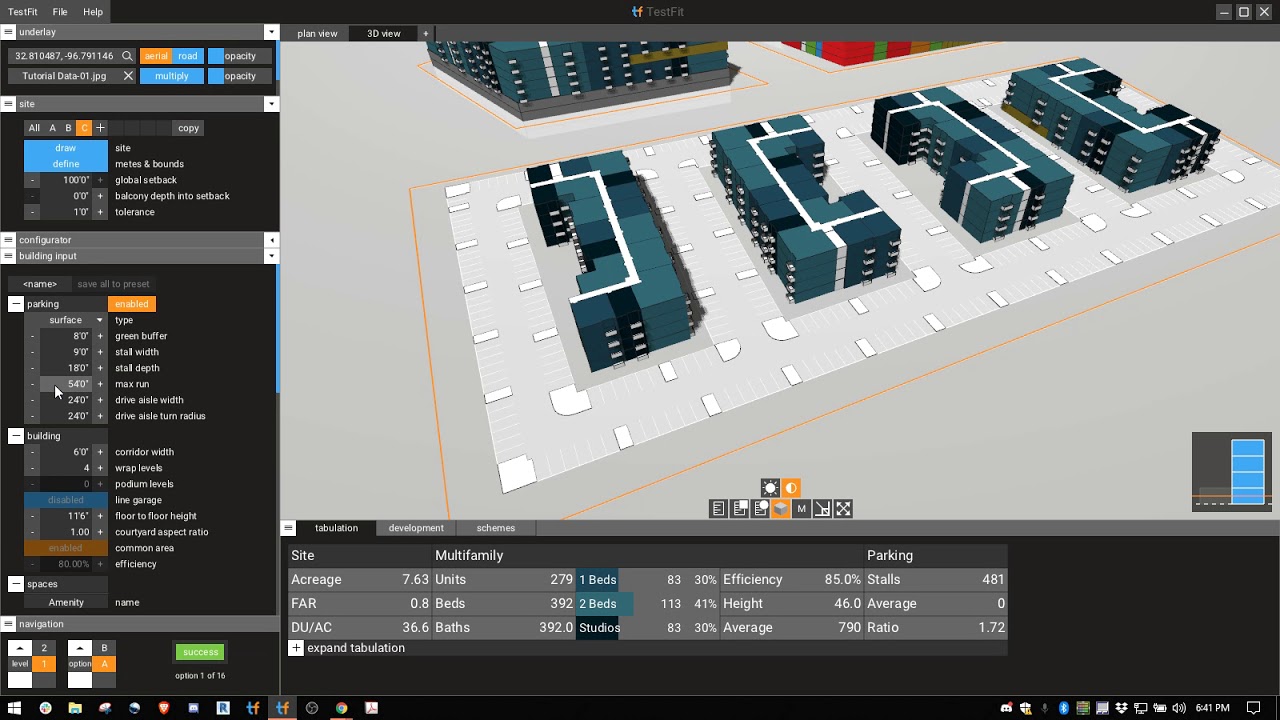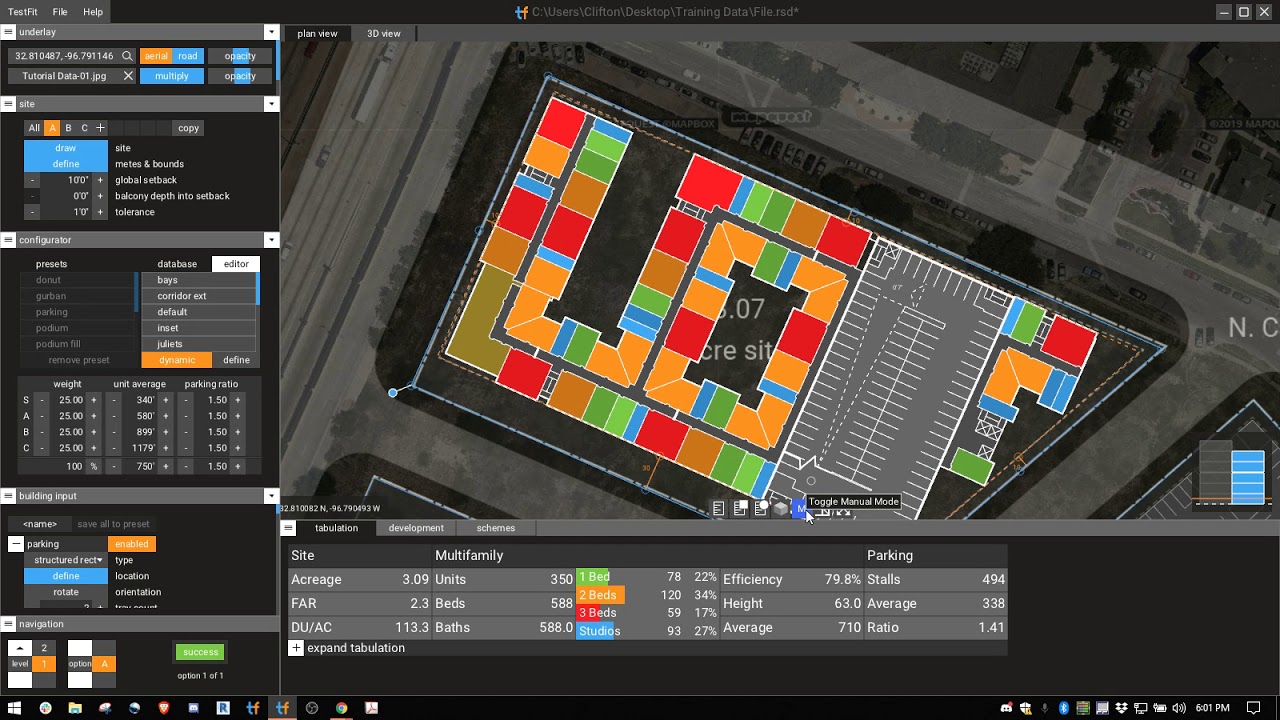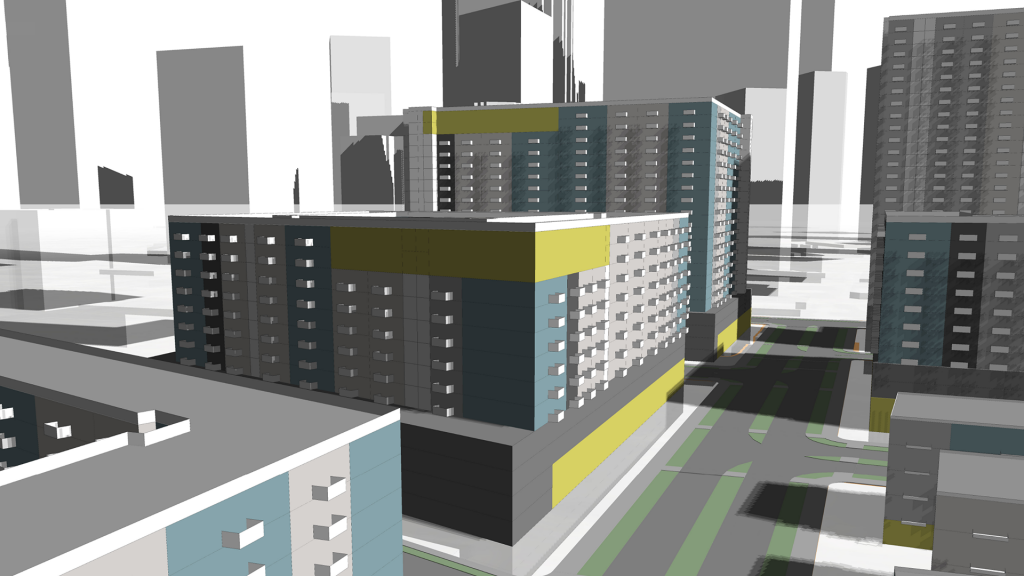We have all been using Computer Aided Design for decades but, the fact is, the computer has hardly aided in the design so far. The last few years have seen a number of interesting design optimisation tools appear, one of which is Testfit.io
As an industry we like to label things. The problem comes when marketing gets involved, tailors a label to the capabilities of a product, and it ends up that everyone has a different definition of what those labels mean.
We already have many phrases in common use: generative design, computational design, design optimisation, rules-based design, algorithmic design, parametric design, data-driven design, AI-based design, the list goes on… There will undoubtedly be more.
The basic fact is the act of design is always a compromise, a trade-off to achieve buildings or infrastructure that works best, conforms to regulation and can be fabricated in a budget.
Unfortunately, the industry has a reputation of delays, budget overruns and sometimes compromised design – there are a slew of reasons for this. BIM has not necessarily been a panacea and, in fact, might contribute to overloading design teams with detail too early on in the process.
With so many competing variables, software developers are now attempting to take some of these burdens off the designer’s shoulders. The areas that every developer has focused on is feasibility and concept design; it’s at this point that fundamental errors can be made and the problem of solving multiple variables is most raw.
There are many formative tools in the space already: Hypar, Digital Blue Foam, Spacemaker.ai (bought by Autodesk), Blox (Gensler internal development), Kreo modular, Blokable, Modelur, Vitruvio, Envelope.city to name but a few. This is probably hardly surprising given the conceptual phase as being the most overlooked in the workflow. Massing rectangles in a BIM tool was never much of an upgrade from pen and paper.
Wading through this market, one company that has stood out to us is Testfit.io, based in Texas and headed up by Clifton Harness. As a straight-talking architect, Harness is building on his vision of a lightning-fast tool that offers a wide range of capabilities to prototype building, site and urban configurations based on real-world variables, solving geometry based on competing variables and constraints such as building codes.
In the space, where applications are targeting early-stage design, there has been a tendency for most of the software development to be skewed towards building developers. This has primarily been because of the slow adoption of this type of technology by architects, and the hard fact that the developers’ superfast evaluation of sites, linked to business metrics like rentable value etc., is easier to justify.
This bias towards development has meant the architectural design community is the loser. Testfit.io is very much catering to architects and early phase design. You don’t need to be able to code to use it and the results are delivered graphically in seconds.
Testfit.io could be seen as a straightforward proposition of productivity benefit. Save time doing the tasks of sheer drudgery, evaluate multiple design options rapidly, and let it assist you in making the right decisions early on, rather than having to alter those designs later.
Interview with Clifton Harness, CEO of Testfit.io
Martyn Day: Where did Testfit come from?
Clifton Harness: I started out in architecture school, got a BArch at the University of Texas. Before I could, you know, become licensfed, I started working in project development, managing architects, doing test fits myself. I then realised that our current system for doing feasibility was quite shit!
I was working till 11 o’clock at night, several days a week. One night I was counting out a parking garage, which involved printing out your whole drawing set and I had to go through and count, and make sure all the numbers were accurate, because the development guys need the numbers, the construction guys needs the numbers. Everybody’s basing their real estate deal off of the architect’s numbers. At 11 o’clock at night I was counting these parking stalls and I just sort of stopped and looked at the wall and I asked myself, ‘do I want a career drawing parking stalls?’
I would finish the set and then tabulate everything and put it on my boss’s desk. He would have gone through and counted everything himself to make sure that my numbers were accurate. He had been doing this for 30 years, he saw no issue with the wasted human effort of counting this crap all day.

So that’s where the innovation is born, out of frustration. I felt like all the architects we worked with were dealing with the same issue, just not having good data. And nobody trusts each other. It’s a problem. I don’t think we’re here to solve that problem, but maybe we can have more trust with an algorithm that can be consistent. Algorithms tabulate the building the same way every single time. Humans can’t do that, we tried, but we’re a little bit imperfect!
The initial program was a pretty powerful Excel spreadsheet in which I could plan out a building to scale. Then it got to a point where I didn’t understand the math that I had to create to solve the unit mixes and everything automatically, so that’s when I brought Ryan in (Ryan Griege, Testfit.io CTO).
Ryan, my college roommate, was working in game development at the time. I’d call him after work and ask him how I could solve this specific math problem! He eventually replied, ‘You don’t, I’ll build you an app that does it’. He created a little terminal application that you’d type in parameters like corridors length, specify the units, hit enter and then it would just do it. It was slow, but it would eventually spit out spreadsheets and a tonne of other things. Then we decided to do create a graphical interface. He built all this software to make me more effective at my job and it just kind of grew from there.
Martyn Day: How long have you been going now?
Clifton Harness: October of 2017 is when we really got started and then we raised money in January of 2020. We built a successful small business first. I mean, this is probably the difference between us and some of the other start-ups out there, is we had to bootstrap.
We had no idea what the venture world was. We had no idea how to sell software. We had no idea how to build a company. We set out with our minimum viable products and by day 20 made our first sale, day 21 we made our second sale.
Martyn Day: So how much of your development has been from you pushing what you think you can develop to solve vs your customers saying what they need?
Clifton Harness: The original roadmap that was in my head is basically done, everything that we’re doing now is customer feedback driven. I was just trying to get a building generated with parking counts and stuff, but our customers have taken it to the next level. All their ideas are excellent.
Some wanted to mix in dimensional constraints, which basically meant ripping out all of the unit generation code, fill the whole constrained environment for what we call them ‘kit of parts’ and embed that into the logic. Now people can do their own custom units inside the app.
While everybody’s crazy about the DfMA there’s enough innovation to be had for design for documentation. It sets projects up for success
That’s really probably our most popular feature today; it certainly is the most valuable feature for design for documentation. If you have an organising principle, like a dwelling unit, that is a static dimension, that means that construction downstream knows how much rent they can get for that. An architect knows exactly what’s in the construction documents for that. That’s how we’re trying to pick up speed, multifamily units, using a kit of parts approach for documentation.
While everybody’s crazy about the DfMA [design for manufacturing and assembly] there’s enough innovation to be had for design for documentation. It sets projects up for success. For some people, success is the drawing output. For others, it’s the fact they looked at 13 options on a site in 20 minutes, and none of them worked. Everybody’s trying to cram these deals down the pipeline that don’t work and that causes a lot of opportunity costs within architecture.
Martyn Day: Commercial developers always seem to push the boundaries of what’s viable.
Clifton Harness: It’s a combination of a couple of things. The developers are trying to achieve profitability in a deal, and they’ve got a lot of levers at their disposal, but the building itself as a deal-making tool is only one of those levers.
They’re going to squeeze the architect to get more. Even if the architect only has a 10 pound bag, you know, the developers like to fit 16 pounds worth of stuff in there!”
Martyn Day: There are many architectural firms that do this early phase almost for free, just to get the job on the detail stage. The result of successive economy crashes perhaps?
An architect, in any market, that undervalues what they think their time is worth, means that everybody else has to compete with that lower threshold
Clifton Harness: I don’t know why they don’t bill for this time. In the US, they essentially will do it for free to get the job. It’s a race to the bottom. You should have a threshold for what you value your time at. An architect, in any market, that undervalues what they think their time is worth, means that everybody else has to compete with that lower threshold. And the problem is, that the output of architecture is not heterogeneous, it’s kind of homogeneous in the eyes of developers.
Architecture is a very hard business to be profitable and to compete in. These firms are not going to have the kind of money to develop custom solutions that would be useful for their own company, or afford the expense of a computational designer, maybe $100k a year. If they want to pick up speed and efficiency, using something like [Autodesk] Dynamo, it’s hard and expensive to get implemented.
Martyn Day: Everybody is looking for the technology that will give the industry a productivity boost. There are high hopes for design for manufacturing and assembly, the problem is the architects aren’t engaging with production and the firm is most likely to adopt the software that is already in fabrication or construction.
Clifton Harness: In the US, 0.3% of new multifamily buildings are modular, DfMA, unit ready. That’s not very many buildings – more than it used to be 10 years ago (around 0.1%) but the current issue with innovation that I see isn’t ‘how do we get to DfMA?’, it’s ‘how do we get to just generating better construction drawings, more quickly?’. That’s the practical innovation, it’s not glamorous. I’m not going to raise, whatever Blokable, or one of these guys that gets millions of dollars to ‘radically change how we do housing’.

Unfortunately, the most good that we can do for housing today is to enable architects to make better CDs [contract drawings] more quickly for the traditional construction types.
I’m probably a stick in the mud, when it comes to wanting to hop on the innovation train and challenge the industry. Everybody is looking way downstream when we’ve got a dumpster fire right here in front of us that we should focus on!
How the architect and the contractor, the developer, the broker, the land seller, the city, the bank, the investors – how all these people communicate with each other. It’s absolutely archaic. It’s with spreadsheets and PDFs and there’s very little tech-enabled firms in the commodity architecture space.
In order to address that market of private development in the United States, we can’t just do one building type, we have to do 15 different building types. We have to do garden apartments, we’ve got to do modular facilities, for hotels modular for a long time and hotel design. By the way, these can be converted into DfMA pretty easily.
Then there’s structured parking, rectangular parking garages are excellent, because they’re precast. Our whole country is obsessed with parking. We had to build a more fluid parking solution for the cast-in-place stuff to address crazy shaped sites. I don’t want to have to build out the whole structural engineering component, but my customers don’t trust the garage layouts, because they didn’t see the columns. We partnered with Thornton Tomasetti to get columns.
Martyn Day: How can architects be more relevant to today’s process?
Clifton Harness: I think if architects want to really own the process, they need to look at themselves, like a spider on a web. How do we connect meaningfully with our data? How do we connect data pipelines meaningfully to our contractor, to our owner, to the developer? How do we actually put ourselves in the centre of this process?

They don’t have construction delivery risk, like the contractor does, they don’t have financial risk like the developer does. And both those groups are going to want to control the risk, they’re going to want to be that spider, they’re going to want to be the thing connecting everything. We’re seeing developers all across the country build out their own contracting company. So what’s the next Domino to fall? Are they going to grab architects too? If there’s not an existential crisis at the AIA [American Institute of Architects] over what the future of this industry looks like, it’s going to be bad.
Martyn Day: Looking at the market today there are many players emerging and then you’ve got the mass domination of companies like Autodesk, who bought Spacemaker.ai Architects’ budgets are tight and the cost of Revit seems to be ever upward.
Clifton Harness: We welcome the challenge. Like everybody says, BIM is a mindset, it’s not a software. Well, it’s because the software is so bad that you can’t make BIM very easy. There is yet to be a software that will accomplish BIM in my mind, just right out the box. And that’s where I’m headed. This is where Testfit is headed, and what we’re going to disrupt. We’re going to do it with commodity buildings. We’re going to do it with architects at the centre, we’re going to get as much detail as we can possibly get, right from the get go, and build a coalition. We have a laser focus on providing specific value.
Conclusion
Harness’ Testfit.io has big aspirations and intends to deliver algorithmic design functionality that is usable and delivers value. Find a common problem that eats time and slows evaluation and they will create a solution for it.
Whilst some systems auto generate hundreds or thousands of design options, Testfit cuts to the chase. The system currently evaluates against 160 different variables but still remains lightning fast. Harness is refreshingly honest and keen to add more building types and test configurations. While the firm has quite a strong US-centric focus regarding building types, Harness has expressed interest in firms opening a dialogue to explore generic design problems. They are certainly up for the challenge.






